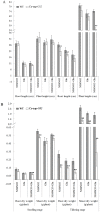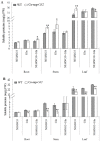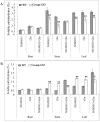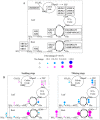The Stable Level of Glutamine synthetase 2 Plays an Important Role in Rice Growth and in Carbon-Nitrogen Metabolic Balance
- PMID: 26053400
- PMCID: PMC4490469
- DOI: 10.3390/ijms160612713
The Stable Level of Glutamine synthetase 2 Plays an Important Role in Rice Growth and in Carbon-Nitrogen Metabolic Balance
Abstract
Glutamine synthetase 2 (GS2) is a key enzyme involved in the ammonium metabolism in plant leaves. In our previous study, we obtained GS2-cosuppressed plants, which displayed a normal growth phenotype at the seedling stage, while at the tillering stage they showed a chlorosis phenotype. In this study, to investigate the chlorosis mechanism, we systematically analyzed the plant growth, carbon-nitrogen metabolism and gene expressions between the GS2-cosuppressed rice and wild-type plants. The results revealed that the GS2-cosuppressed plants exhibited a poor plant growth phenotype and a poor nitrogen transport ability, which led to nitrogen accumulation and a decline in the carbon/nitrogen ratio in the stems. Interestingly, there was a higher concentration of soluble proteins and a lower concentration of carbohydrates in the GS2-cosuppressed plants at the seedling stage, while a contrasting result was displayed at the tillering stage. The analysis of the metabolic profile showed a significant increase of sugars and organic acids. Additionally, gene expression patterns were different in root and leaf of GS2-cosuppressed plants between the seedling and tillering stage. These results indicated the important role of a stable level of GS2 transcription during normal rice development and the importance of the carbon-nitrogen metabolic balance in rice growth.
Keywords: GS2; carbon-nitrogen; chlorosis; gene expression; metabolic profile; rice.
Figures








References
Publication types
MeSH terms
Substances
LinkOut - more resources
Full Text Sources
Other Literature Sources

